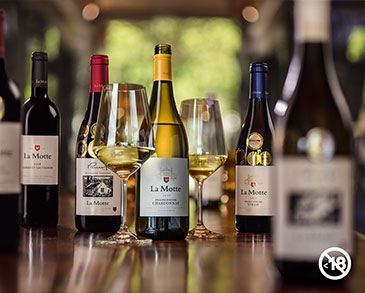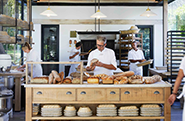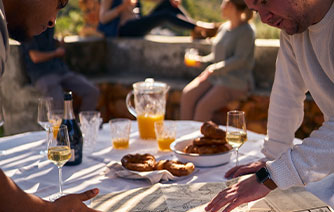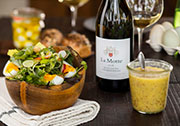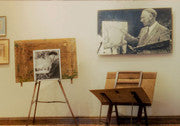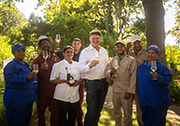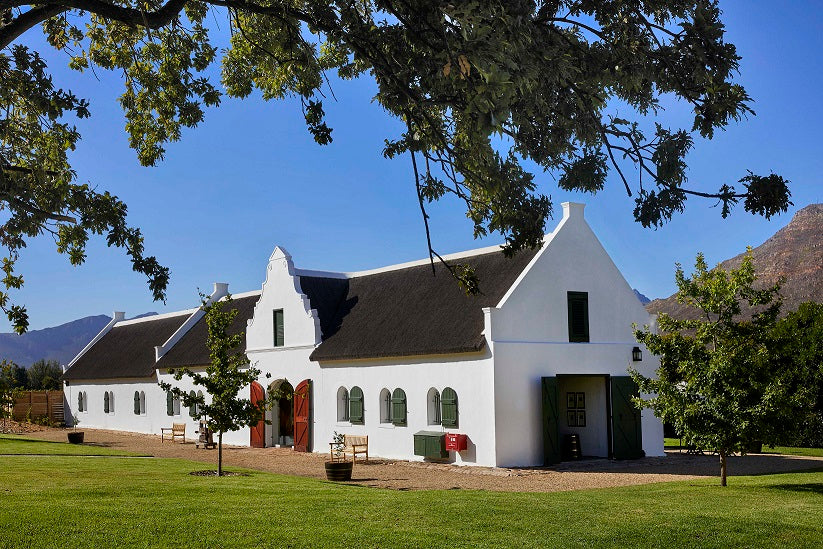
The historic red wine cellar on La Motte dates from between 1770 and 1782 and has a rich and interesting history.
The front gable of the Historical Cellar on La Motte reads anno 1825 with the initials “GJB” for Gideon Jacobus Joubert engraved onto it. This date does, however, only refer to the construction date of the gable during the ownership of Gideon Joubert, La Motte’s eighth owner. The building itself is far older and has much to tell.
Four of the historical buildings on La Motte including the Jonkershuis (home to the La Motte Artisanal Bakery & Garden Café), Manor House, Historical Cellar, and the Watermill, are believed to have been built during the time of Gabriel du Toit, La Motte’s fourth owner who lived on the farm from 1751 until 1793. In recent times these buildings were restored by the Rupert Historical Building Trust and received National Monument status in 1975. Today this complex is classified as a Provincial Heritage site according to the South African Heritage Resources Agency (SAHRA).
These historical structures are in the style of the Cape Dutch building tradition that refers to the stylistic influences from the Renaissance Classism, Baroque, Rococo, and Neoclassical. The visual characteristics are reflected in the steep thatched black roofs, white lime-washed walls, gables placed in the centre of the façade, and the use of symmetry.
The gable of the historical cellar is in a Neoclassical style with stylistic touches of Baroque. The Neoclassical style is synonymous with geometrical shapes, as is evident in the triangular pediment on the top of the gable and a focus on vertical emphasis like the pilasters.
One of the interesting facts about the historical cellar is that the back gable, which was restored to replicate the front, used to look much different as pictured here. These photographs were taken by Arthur Elliott in the 1920s and show the cellar as a working building during the Rhodes Fruit Farms period.


It is also interesting that over time the cellar was extended only in length, which was out of the norm but justified due to its function as a working cellar. The rest of the windows have a curved top that indicates the change of styles and is more characteristic of the later Rococo influence.
For the interior of the historical cellar, yellow wood beams have been used for the ceiling, and terracotta tiles for the floor. Stone was used for the walls as seen at the exposed square in the corner of the entrance. Farmers would have tried to use what was available on-site to reduce building costs and transportation of materials on the poor roads at that time.
The French oak barrels were acquired by Anthonij Rupert in 1984 for the first wines of La Motte under the Rupert family’s ownership. Later they were decorated with engravings of family crests, of the first-generation French families to come to the Franschhoek Valley.
Over the years, the historic cellar served as a production space for wine and small quantities of brandy. In 1753 there were 4 000 vines registered on La Motte. By 1773 there were 15 000 vines, and by 1782 there were about 25 000 vines which would likely have necessitated a cellar. From 1834 production grew from 40 000 vines to 73 000 in 1835 as Joubert was granted more land. At the time, he produced 46 “lêers” of wine (almost 26 000ℓ) and brandy production doubled. In later years from the early 1900s, it would have been used for fruit sorting and packing during the Rhodes and Cochranes’ ownership.
Moving forward into recent history, classical music concerts were introduced in the cellar in 2002 in celebration of La Motte's owner, Hanneli Rupert-Koegelenberg's love for music and her career as a mezzo-soprano. Over the next two decades acclaimed local and international musicians graced the stage of this intimate concert room. Today, the historical cellar serves as a temporary Wine Tasting Room during a renovation phase. A fitting use in the ongoing evolution of this historical workspace.

